This talk was presented at the First International Symposium on the Science of Creative Intelligence, which was held at the University of Massachusetts, Amherst, on July 19, 1971. Dr. Max Raines, Professor of Higher Education, Michigan State University, was symposium chairman.
In response to a question on the relationship between creativity and suffering, Maharishi cited the definition of creativity from the symposium pamphlet and asked, since creativity is both progressive and evolutionary, and pain hampers even existence itself, how can they be related? How is it that some individuals whose lives were full of suffering were also very creative? —Rhoda Orme-Johnson, Ph.D., and Susan Anderson, Ph.D., editors of The Flow of Consciousness1
The Relationship between Creativity and Suffering
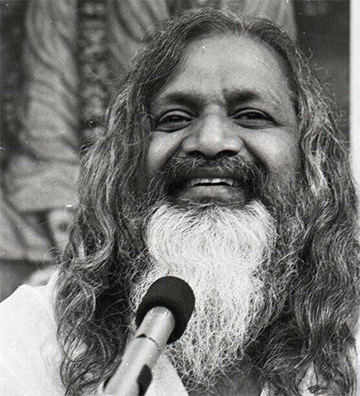
Maharishi at the First International Symposium on the Science of Creative Intelligence, July 19, 1971 (Photo 2)
Maharishi: There are two things that you are confronted with: pain and creativity. I would like to draw your attention to the definition of creativity, which Dr. Raines has mentioned from that pamphlet of the symposium: Creativity is that impelling life force which manifests in different forms and behavior and activities.2 That impelling life force.
From this what we find is [that] creativity is the blossoming of life. Life as if dances through the waves of creativity. It’s the dance of life; it’s the laughter of life; it’s the music of life.
Now, this being the reality of creativity, pain and suffering, if anything, are opposed to it. Creativity is progressive; it’s evolutionary; it makes life blossom in greater or higher stages of development. It’s the music of life through which life laughs and dances and progresses. Pain is something which hampers even existence. Pain even threatens existence, brings discomfort to the state of existence, what to say of bringing evolution to it!
Now, this being the principle, these two areas, pain and creativity, don’t seem to have any common ground. But history has shown many people who were suffering and were found to be creative. Now, we must be able to see clearly into this phenomenon. Whereas pain is opposed to creativity, how it is that many people who live a life of suffering happen to be good, creative people?
Creativity is progressive; it’s evolutionary; it makes life blossom in greater or higher stages of development. It’s the music of life through which life laughs and dances and progresses.
Relief from Suffering through Creativity
We should be able to account for this, and it’s very simple to see that what any suffering man wants is to escape from suffering; he wants to be out of suffering. And for that, what does he do? Anything that he could do, he would do to come out of suffering.
That means he would start to do something which would be in any way pleasing to him, in whatever degree—something pleasant. In this relativity, not all happiness would be there, not all suffering would be there. There would be something besides suffering.
Maybe a man is poor and suffering from environmental disorders and inadequacies. But then there is something he could do. He could play music or sing something, compose music, or do something, paint some picture.
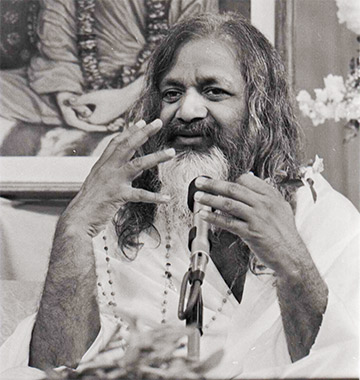
Maharishi explains the principles of the Science of Creative Intelligence. (Photo 3)
Now, this art of painting, or composing a poem, is a solace to him. Even with all the inadequate environment full of poverty, all the banks of poverty in the various areas in life, even then he can start to swing in ecstasy, in that melody, or in the rhyme of a poem, or whatever, in music, and these moments are the moments in which he finds relief, solace.
And in these moments of solace, moments of relief, he has reduced to some degree the pain in his level of awareness. Some pain is reduced. This forgetting of the pain and getting absorbed in the joy of life is a step toward positive creativity.
And when a man full of troubles has even a very slight degree of elation, something, he feels such a great contrast that he gets absorbed in that happiness, which to some ordinary other man may be very trifling. But for him it’s a great contrast from his constant and great suffering to some moments of relief, and then his heart is creative.
This forgetting of the pain and getting absorbed in the joy of life is a step toward positive creativity.
Increasing Happiness and Creativity
It is this increased happiness which provides a step of creativity. And then, whatever he undertakes to do, it doesn’t matter what, whether he composes a poem, or he writes a book or a novel or paints a picture or makes a sculpture, anything, it gives him some solace. In this increasing happiness, creativity blossoms, because, as we have seen, life is by nature evolutionary.
Creative intelligence is evolutionary, so that in any moment of greater happiness, that evolutionary force overtakes life and produces something. And then, the next moment, little bit more and more and more.
So all works of art, or works of any creative value that any artist has ever produced, he has produced on the steps of increasing joyfulness, and with this act of creativity, his life danced, amused itself, and evolved, and these works of art remain. They were not the creation of the suffering of the artist; they were the creation of the steps of joyfulness that that work provided for him, even though the other aspects of his life were full of suffering.
All works of art… that any artist has ever produced, he has produced on the steps of increasing joyfulness, and with this act of creativity, his life danced, amused itself, and evolved, and these works of art remain.
Creation of Art from Steps of Joyfulness
So even a writer who wrote all his books about suffering, suffering, suffering, even then there was that peace to establish that not all moments of his life were lived in suffering. He was progressively creative on his steps of joyfulness. This is how we would account for the great creative value of even those who have been suffering.
Creativity and suffering don’t go together. But because creativity brings the joy of life, a wave of joyfulness, which is a solace from suffering, which everyone entertains and desires and goes for, one becomes creative.
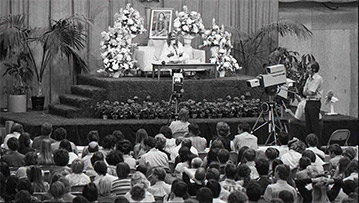
Maharishi answers questions at the First International Symposium on the Science of Creative Intelligence, University of Massachusetts, Amherst, July 1971. (Photo 4)
And it can be that a suffering man may be very creative because of the contrast from his state of suffering to the small steps of achievement in his creative intelligence. In this way we would like to account for the creativity of those whose life was the life of suffering.
Dr. Raines: I would like to ask about that. Could it be that when a man has a vision of possibilities, then as long as he is in tune with that vision, he is experiencing joy? When he momentarily loses that vision, he regresses to some degree of pain and suffering, thinking maybe what the consequences of thinking differently might be, something may happen. Then he comes back and says, “But no, the vision is right,” and he captures it again.
Does he move in and out in some way here, and thus perhaps, when we observe from the outside, we see the part when he is showing or feeling some doubt, and don’t share with him the inner joy of the assurance of what he’s doing?
Creativity and suffering don’t go together. But because creativity brings the joy of life, a wave of joyfulness, which is a solace from suffering… one becomes creative.
Establishing the Goal of Life in the Artist’s Awareness
Maharishi: It’s a beautiful point. If he loses sight of the goal, he may dwindle off and on. Now, the goal is the infinite value of life, and if that could get established in the level of one’s awareness, the goal would never be lost; not only never lost to vision at a distance, but never lost to life as it is lived from moment to moment, now. And in this state, one is most creative.
In that state of Cosmic Consciousness,3 to have a specific word for it, where individual awareness is supported by that unbounded pure consciousness, in that state the goal is a reality of every moment, and therefore, the vision of the goal is never lost, and therefore, creativity is never dwindling, never on the dwindling level. It’s fixed and maximum.
Otherwise, when the goal is lost to vision, one may go through all that you said. That is why we want to create a situation in which not only is the vision of the goal not lost, but we live this state of the goal, and then creativity is maximum, without dwindling to any minimum level. So stabilizing the pure field of creative intelligence on the level of our conscious mind is a technique for sustaining waves of creative intelligence.
Where individual awareness is supported by that unbounded pure consciousness… the vision of the goal is never lost, and therefore, creativity is never dwindling… It’s fixed and maximum.
Order The Flow of Consciousness here ►

Rhoda Orme-Johnson, Ph.D., Professor Emeritus at Maharishi University of Management (MUM), was a founding faculty member of Maharishi International University (MIU) in 1973, and of MERU (Maharishi European Research University) in 1974, and chair and award-winning professor of the MIU/MUM Literature Department until 1996. Her seminal article “A Unified Field Theory of Literature” (Modern Science and Vedic Science 1 (1987):323-373) has been the basis of literary study at MUM since its publication. Learn more about her remarkable life, writing, and other books at RhodatheWriter.com.
Susan Andersen, Ph.D., was Professor of Literature at Maharishi University of Management from 1981 to 2003, and served as department chair from 1996 to 2003. She also produced “Masterpieces of World Literature,” a radio show broadcast from Maharishi University of Management that discussed literature from the perspective of Vedic Science.
Notes
1. Rhoda F. Orme-Johnson, Ph.D., and Susan K. Anderson, Ph.D, The Flow of Consciousness, MUM Press, 2010.
2. In the symposium pamphlet, creative intelligence was defined as “that impelling life force which manifests itself in the evolutionary process through creation of new forms and new relationships in the universe” (International Symposium on the Science of Creative Intelligence, Summer 1971, University of Massachusetts, Amherst/Humboldt State College, Arcata. Spain: Maharishi International University Press, 1971: 12).
3. Maharishi defines Cosmic Consciousness as the ability to maintain the unbounded, blissful nature of pure consciousness along with thoughts, activity, and even deep sleep, so that the experiencer operates on a background of inner fullness and bliss, of “eternal happiness.” The state of Cosmic Consciousness is not a mood nor the result of understanding some concept; it is a physiological state cultured through repeated experience of pure consciousness.
Photo Credits
Albertson, Jeff. Maharishi Mahesh Yogi at the University of Massachusetts Amherst, July 1971: (1) Top banner: Maharishi on stage; (2 & 3) closeup of Maharishi on stage; (4) audience, cameramen, and Maharishi on stage. Jeff Albertson Photograph Collection (PH 57). Special Collections and University Archives, University of Massachusetts Amherst Libraries.

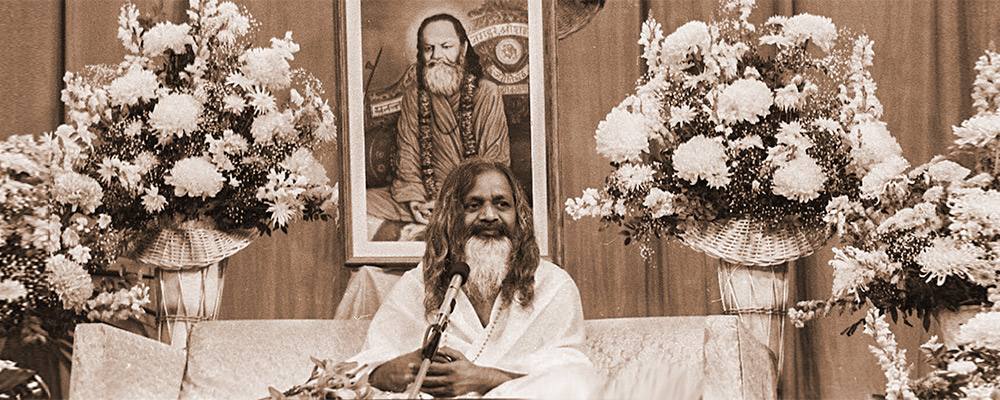



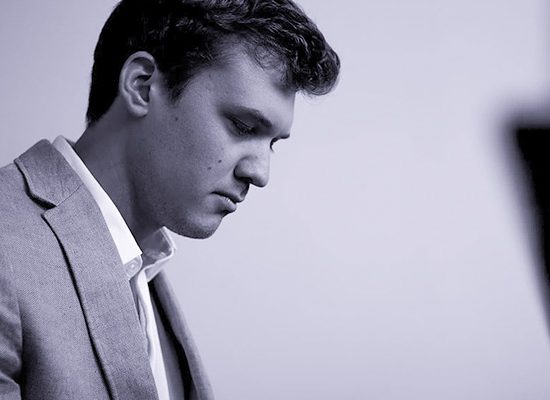
Uplifting and encouraging article.